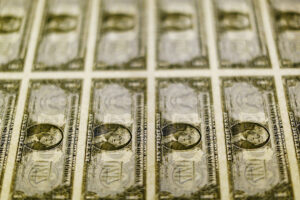




Policy Rate Updates: Double cut finale
 DOWNLOAD
DOWNLOAD

Monthly Economic Update: One for the road
 DOWNLOAD
DOWNLOAD

Inflation Update: Still low, still slow
 DOWNLOAD
DOWNLOAD


PH eyes USD 2B retail dollar bond offer in Q3

THE PHILIPPINE government may launch a retail dollar bond offering in the third quarter of 2023, National Treasurer Rosalia V. de Leon said.
At a briefing on Friday, Ms. De Leon said the offer size will be around USD 2 billion, surpassing its previous retail dollar bond issuance.
The Philippines’ last retail dollar bond sale was in 2021, when it raised almost USD 1.6 billion or PHP 80.91 billion.
“We are looking for a more comfortable exchange rate. It’s a moving target, we’re now looking at the third quarter. We are planning this carefully, because otherwise we’ll be adding more debt,” she said.
The peso has recently weakened against the US dollar. The local currency closed at PHP 55.79 versus the US dollar on Friday, inching down by four centavos from Thursday’s PHP 55.75 finish.
Last month, Ms. De Leon said the government was looking to offer USD 1.5-billion retail dollar bonds in May.
She said the government will market the retail dollar bonds to overseas Filipino workers (OFWs) through multiple platforms such as the Bonds.PH app, the LANDBANK mobile app, and selling agents.
To make it easier to buy the retail dollar bonds, Ms. De Leon said they’re trying to get some banks to waive the fees for opening dollar accounts.
“Apparently, there are fees, so we are going to the agent banks to consider waiving those fees. We want to make sure everything is smoothened out so we will have a good reception,” she said.
“We have to look at market conditions, so that it will be a bigger volume. We really have to waive the (bank) fees.”
Finance Secretary Benjamin E. Diokno emphasized that anyone can buy the retail dollar bonds, not just OFWs.
In January, the government raised USD 3 billion from its second global bond offering under the Marcos administration.
Borrowing program
Meanwhile, Ms. De Leon said there will likely be no adjustment to the government’s current borrowing program.
The government plans to borrow PHP 2.207 trillion this year, of which 75% will be sourced locally. The government plans to borrow PHP 1.654 trillion domestically and PHP 553.5 billion from overseas.
“We will have to calibrate based first in terms of the spending, and at the same time collection,” she said, noting the Bureau of Internal Revenue’s and Bureau of Customs’ recent revenue performance.
“If that will continue, we will be able to shrink the deficit for the year and we can also reduce borrowings for the year, just as we did last year,” she added.
The National Government’s (NG) budget deficit narrowed by 14.51% year on year to PHP 270.9 billion in the first quarter, as revenues improved, and expenditures dropped.
Ms. De Leon also said that she expects debt levels to decline in the next few months, as the government borrows less.
“Going forward, we also see that this (debt) will decline. First, we have redemptions. There are retail Treasury bonds that are maturing. At the same time, the deficit is narrowing. For this year, our deficit will be 6.1% of gross domestic product (GDP),” she said.
The NG’s outstanding debt stood at a record-high PHP 13.86 trillion as of end-March.
“We will be borrowing less to finance the deficit. At the same time, we want to look at it not just in terms of the volume of debt we are borrowing but how it’s contributing to the growth of the economy. The productive economy is growing because of the resources we are (using) to be able to finance the expenditures of the government,” Ms. De Leon said. — By Luisa Maria Jacinta C. Jocson, Reporter
This article originally appeared on bworldonline.com





 By BusinessWorld
By BusinessWorld